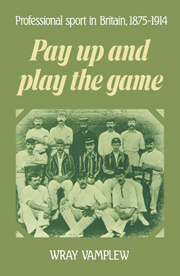Book contents
- Frontmatter
- Contents
- List of tables
- Preface
- Acknowledgements
- A guide to prices, 1870–1914
- Part I An overview
- Part II The development of professional gate-money sport
- Part III Sport in the market place: the economics of professional sport
- Part IV Playing for pay: professional sport as an occupation
- 12 The struggle for recognition
- 13 Earnings and opportunities
- 14 Close of play
- 15 Not playing the game: unionism and strikes
- 16 Labour aristocrats or wage slaves?
- Part V Unsporting behaviour
- Part VI A second overview
- Appendices
- Notes
- Bibliography
- Index
16 - Labour aristocrats or wage slaves?
Published online by Cambridge University Press: 16 February 2010
- Frontmatter
- Contents
- List of tables
- Preface
- Acknowledgements
- A guide to prices, 1870–1914
- Part I An overview
- Part II The development of professional gate-money sport
- Part III Sport in the market place: the economics of professional sport
- Part IV Playing for pay: professional sport as an occupation
- 12 The struggle for recognition
- 13 Earnings and opportunities
- 14 Close of play
- 15 Not playing the game: unionism and strikes
- 16 Labour aristocrats or wage slaves?
- Part V Unsporting behaviour
- Part VI A second overview
- Appendices
- Notes
- Bibliography
- Index
Summary
The earnings of successful professional sportsmen were high relative to other working-class incomes. No working man, no matter how skilled, could hope to match the money of top jockeys, and even the £4 a week of the professional footballer would be envied by most workers. On such an economic criterion there would be a strong claim for at least the higher echelons of professional sportsmen to be categorised as members of the labour aristocracy, that ‘distinctive upper strata of the working class, better paid, better treated, and generally regarded as more respectable and politically moderate than the mass of the proletariat’. Yet, as this definition implies, the issue was not just one of earnings. As a group the labour aristocrats are considered to have differed from other sections of the working class in job security, life style, political attitudes, relationships with employers, and their willingness and ability to unionise and organise other cooperative enterprises. On these grounds it is difficult to include sportsmen within the ranks of the labour aristocracy, though far more biographical research is needed before firm conclusions can be drawn.
Sportsmen had little long-term job security, simply because ageing muscles brought declining physical prowess which, apart from a few jockeys and the exceptional cricketer, generally failed to be offset by experience and tactical nous. There were also more immediate problems caused partly by injuries, an occupational hazard, but mainly by the lack of any power to restrict entry to the profession.
- Type
- Chapter
- Information
- Pay Up and Play the GameProfessional Sport in Britain, 1875–1914, pp. 254 - 256Publisher: Cambridge University PressPrint publication year: 1988



